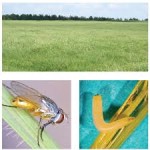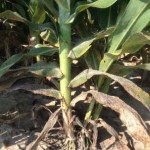by Robert Bowling
Bermudagrass Stem Maggot – The Bermudagrass stem maggot (BSM), Atherigona reversur, is native to several Asian countries. In 2010 it was reported damaging bermudagrass from three counties in Georgia. This invasive fly quickly spread across the southern U.S. and, in 2013, was first reported infesting bermudagrass in Texas.
The adult BSM is a small yellowish fly with dark eyes. It lays eggs on the bermudagrass stem near a node. The immature (maggot or larva) stage is yellowish and grows to about 1/8th inch long. Larvae are generally hard to find because they frequently have left the stem by the time plants show symptoms of damage. There are multiple generations each summer. The BSM lifecycle lasts about 3 weeks, but may be as short as 12 days.
It is the immature BSM responsible for damage to bermudagrass. The larva will work its way toward a node shortly after hatching from the egg. As the larva develops it will burrow in the shoot and feeds causing leaves above the feeding site to wither and die. Bermudagrass damaged by BSM will have a frosted appearance. Shoot elongation stops as a result of the insect’s feeding. The plant may grow another shoot from a lower node of the damaged shoot. However, the new shoot can be attacked by later generations of the bermudagrass stem maggot.
Infestations are usually worse in late summer. The severity of damage to bermudagrass often is dependent on the point during regrowth when the flies lay their eggs. Conditions favoring rapid pasture growth rates, i.e. good soil and moisture conditions, may delay damage and loss of the last 1 to 3 leaves seem to have a minimal impact on yield. Conversely, producers have reported major yield losses during poor growing conditions. Early harvest is suggested when infested fields are within seven days of the normal harvest stage. Heavily infested fields should be harvested earlier. Baled grass should be removed from the field to limit subsequent infestations of BSM.
Although all bermudagrass varieties are reported to be susceptible to BSM, coarse stemmed varieties often have fewer affected stems. Research from Georgia and Japan suggest that thicker-stemmed varieties (e.g. Tifton 85, Coastcross-I, Tifton 68, etc.) have fewer stems affected by the damage as a proportion of the number of stems per unit area when compared with finer textured varieties.
Infested fields should be treated with a foliar-applied insecticide within a few days following harvest. A second application may be warranted in cases of severe infestations. Relatively low rates of pyrethroids insecticides should provide effective control of adults helping to limit reinfestation. Read and follow label directions carefully as pre-harvest intervals will differ among pyrethroid insecticides.
Sugarcane Aphid: This season the sugarcane aphid (SCA) has been somewhat of a minor issue when compared with the widespread challenges it caused to sorghum production in 2014. A number of peers have offered suggestions and speculation for the lack of SCA infestations this season. Some reasons for slow SCA growth in sorghum include extreme rain events throughout the winter and spring, early build-up of predator and parasite populations, disease among aphid populations, cooler than normal conditions inhibiting aphid population growth, etc.
The majority of speculative causes for slow population growth among the SCA have merit. One obvious difference between 2015 and the previous couple of years has been abundant rain this season. Sugarcane aphid population growth appears to increase during periods of hot and dry conditions, especially in periods of drought. Aphid predators, such as syrphid fly larvae and ladybugs, and parasitoids, were prevalent in the late-winter and spring. These natural enemies were common among SCA populations overwintering on Johsongrass and volunteer sorghum. They, too, have played an important role in suppression of SCA on sorghum. However, recent changes in weather patterns to warmer and drier conditions have resulted in rapid SCA population growth in many sorghum fields. There has been an increase in insecticide applications in sorghum for SCA over the past couple of weeks.
It is important to continue monitoring sorghum for SCA infestations. Late-planted sorghum will be particularly vulnerable to the aphid. Keep in mind that this aphid occurs in clumps within a field. Consequently, it is important to do a thorough inspection of each field when monitoring the aphid. Check the top (leaf below the flag leaf) and bottom most green leaf on 10 to 20 plants in each of four locations within a field. Avoid checking consecutive plants within a location. It is important to check plants in different areas within each location. This will help make a more informed decision on the need for an insecticide application. Keep in mind that the threshold in 50 to 125 aphids per plant.
Edge treatments and spot spraying have been made where SCA are isolated within a field. This is a good practice when fields are thoroughly scouted and the SCA infestation is localized within a field. Otherwise, the entire field should be treated when the threshold is reached. Don’t forget to check for SCA prior to applying a harvest aid. Consider adding an insecticide if the aphid is present on the upper leaves. Malathion will offer some suppression of the aphid and it has a 7 day pre-harvest interval. Transform will provide a better control of SCA but it has a 14 day pre-harvest interval. Always read and follow label direction carefully prior to using any pesticide.
Sorghum Headworm and Sorghum Midge: Many late seeded sorghum fields are heading and flowering at this time. These fields will be attractive egg laying sites for headworm and midge. Scout carefully for these insects in late-seeded sorghum. The economic thresholds vary based on plant population and crop value. Please see the following site for more information on determining thresholds for various sorghum head insects https://insects.tamu.edu/extension/apps/sorghumheadwormcalculator/. There have been some reports of inadequate control of headworm with pyrethroids, especially larger worms.

Randy Bowling
Assistant Professor and Extension Specialist, College Station, TX robert.bowling@ag.tamu.edu



